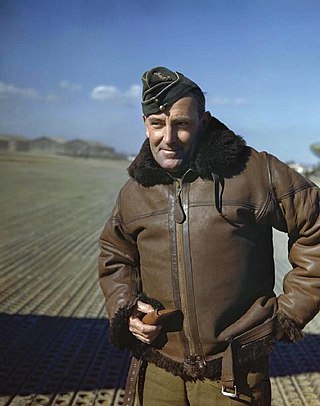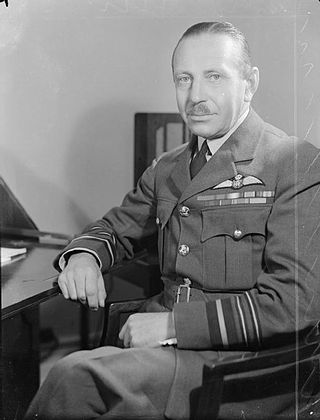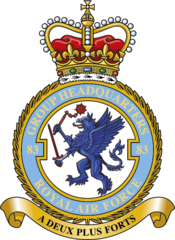
The Desert Air Force (DAF), also known chronologically as Air Headquarters Western Desert, Air Headquarters Libya, the Western Desert Air Force, and the First Tactical Air Force (1TAF), was an Allied tactical air force created from No. 204 Group RAF under RAF Middle East Command in North Africa in 1941 to provide close air support to the British Eighth Army against Axis forces. Throughout the Second World War, the DAF was made up of squadrons from the Royal Air Force (RAF), the South African Air Force (SAAF), the Royal Australian Air Force (RAAF), the United States Army Air Forces (USAAF) and other Allied air forces.

The Twelfth Air Force (12 AF; Air Forces Southern, (AFSOUTH)) is a Numbered Air Force of the United States Air Force Air Combat Command (ACC). It is headquartered at Davis–Monthan Air Force Base, Arizona.

The RAF Third Tactical Air Force, which was formed in South Asia in December 1943, was one of three tactical air forces formed by the Royal Air Force (RAF) during the Second World War. It was made up of squadrons and personnel from the RAF, Indian Air Force (IAF) and the air forces of other Commonwealth countries. Third TAF was formed shortly after the establishment of South East Asia Command to provide close air support to the Fourteenth Army.

No. 2 Group is a group of the Royal Air Force which was first activated in 1918, served from 1918–20, from 1936 through the Second World War to 1947, from 1948 to 1958, from 1993 to 1996, was reactivated in 2000, and is today part of Air Command.

Royal Air Force Germany, commonly known as RAF Germany, and abbreviated RAFG, is a former command of the Royal Air Force (RAF) and part of British Forces Germany (BFG). It consisted of units located in Germany, initially in what was known as West Germany as part of the British Air Forces of Occupation (BAFO) following the Second World War, and later as part of the RAF's commitment to the defence of Europe during the Cold War. The commander of RAFG doubled as commander of NATO's Second Allied Tactical Air Force (2ATAF). Its motto was 'Keepers of the Peace'.

Air Chief Marshal Sir Harry Broadhurst,, commonly known as Broady, was a senior Royal Air Force commander and flying ace of the Second World War.

Air Marshal Sir Arthur Coningham,, nicknamed "Maori", was a senior officer in the Royal Air Force. During the First World War, he was at Gallipoli with the New Zealand Expeditionary Force, was discharged in New Zealand as medically unfit for active service, and journeyed to Britain at his own expense to join the Royal Flying Corps, where he became a flying ace. Coningham was later a senior Royal Air Force commander during the Second World War, as Air Officer Commanding-in-Chief 2nd Tactical Air Force and subsequently the Air Officer Commanding-in-Chief Flying Training Command.
The term Tactical Air Force was used by the air forces of the British Commonwealth during the later stages of World War II, for formations of more than one fighter group. A tactical air force was intended to achieve air supremacy and perform ground attack missions.

Air Marshal Sir John Henry D'Albiac, was a senior commander in the Royal Air Force during the Second World War. Notably he was the British air commander for the Battle of Greece.

No. 83 Expeditionary Air Group is a group within the Royal Air Force, currently based at Al Udeid Air Base in Qatar.

Air Marshal Sir Richard Llewellyn Roger Atcherley, was a senior Royal Air Force officer. He served as Commander-in-Chief of the Royal Pakistan Air Force from 1949 to 1951. His final appointment before retiring from the RAF was Air Officer Commanding-in-Chief of Flying Training Command.

Northwest African Air Forces (NAAF) was a component of the Allied Mediterranean Air Command (MAC) during February–December 1943. It was responsible primarily for air operations during the Tunisian Campaign and bombing of Italy. Its commander was Lieutenant General Carl Spaatz of the United States Army Air Force. NAAF was created following a reorganization of the command structure of Allied air forces in the Mediterranean Theatre. The other components of MAC were Middle East Command (MEC), AHQ Malta, RAF Gibraltar and 216 Group.

The Mediterranean Allied Air Forces (MAAF) was the major Allied air force command organization in the Mediterranean theater from mid-December 1943 until the end of the Second World War.
The Mediterranean Air Command (MAC) was a World War II Allied air-force command that was active in the North African and Mediterranean Theater of Operations (MTO) between February 18 and December 10, 1943. MAC was under the command of Air Chief Marshal Sir Arthur Tedder, whose headquarters were next to those of the Supreme Allied Commander, General Dwight D. Eisenhower, in Algiers, Algeria, during the planning of the Allied campaigns in Tunisia, Pantelleria, Sicily, and the invasion of mainland Italy during the war.
The Northwest African Tactical Air Force (NATAF) was a component of the Northwest African Air Forces which itself reported to the Mediterranean Air Command (MAC). These new Allied air force organizations were created at the Casablanca Conference in January 1943 to promote cooperation between the British Royal Air Force (RAF), the American United States Army Air Force (USAAF), and their respective ground and naval forces in the North African and Mediterranean theater of World War II. Created on February 18, 1943, the NATAF and other MAC commands existed until December 10, 1943, when MAC was disbanded and the Mediterranean Allied Air Forces (MAAF) were established.

No. 205 Group was a long-range, heavy bomber group of the Royal Air Force (RAF) established on 23 October 1941 by boosting No. 257 Wing to Group status.

No. 211 Group RAF is a former Royal Air Force group which disbanded in September 1943. It initially formed in December 1941, then disbanded in February 1942. The group immediately reformed in March 1942 as No. 211 Group within RAF Middle East Command.

No. 242 Group was a group of the British Royal Air Force (RAF) formed on 24 August 1942. Its first commander was Air Commodore George Lawson.
Air Marshal Sir John Humphrey Edwardes-Jones, was a senior Royal Air Force commander.
Air Vice Marshal James Rowland Scarlett-Streatfeild, was a senior commander in the Royal Air Force during the Second World War. He was killed in an air crash as he travelled to accept the surrender of German forces in Norway.















